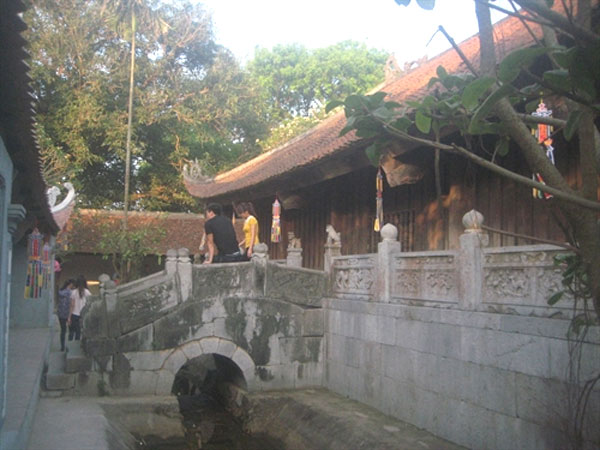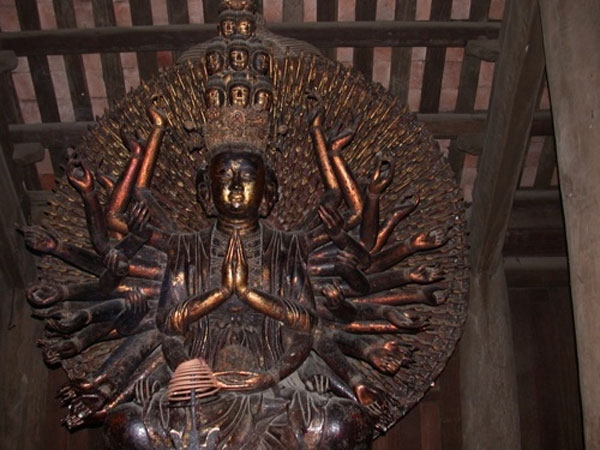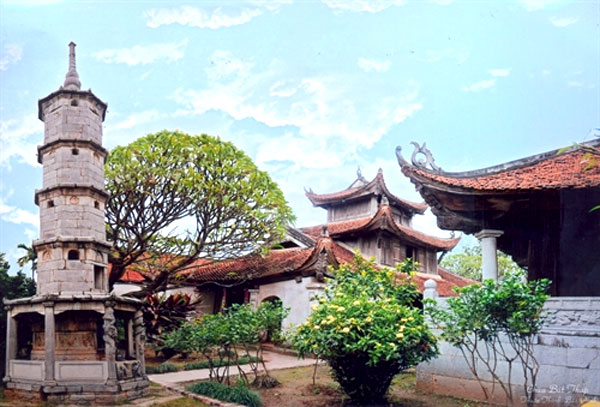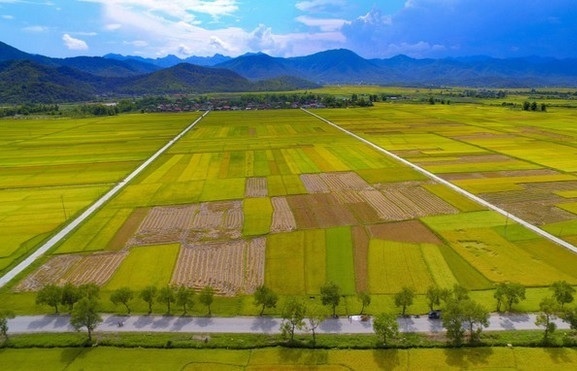Ancient But Thap Pagoda continues to enchant locals and tourists
 |
| Ancient architecture: A small stone bridge with 13 stone engravings in the centre of the pagoda shows the way to Nirvana.-VNS Photo Bach Lien |
When she was a student, she lived in Bac Ninh Province for a few months to do an internship. In the afternoons, she used to ride her bike along the Duong River, then, sit on the slope of the dyke to watch the ferries passing on the river and watch the kites soaring above her head.
She was particularly taken with the sound of a bell ringing from a nearby pagoda, which brought back many memories.
The poetic beauty of the pagoda, surrounded by straight areca trees and green rice and maize fields, also touched her.
From a distance, she could also admire the high stone bell-tower in the shape of a giant pen which reaches skywards, above the sugar-cane and paddy fields. She learned that the pagoda’s name is But Thap (the Pen Tower).
The pen tower symbolises locals’ love of studying. Despite being one of the smallest provinces of the country, Bac Ninh led the country in the number of top scholars under the feudal regime (12 out of the country’s total 46).
A literature teacher, she is very interested in the province’s learning tradition.
More than forty years have passed since then, but my mother has never forgotten the magical sound of the bell and the ancient beauty of the pagoda. She’s always planned to come back and visit it again.
She was not disappointed. The pagoda hadn’t changed.
Ancient beauty
She was touched to see the pagoda’s old gate once more, shaded by ancient giant banyan tree lines. The areca trees are still there, casting shadows that helps ease the summer heat waves.
Passing through the mossy gate, I was myself surprised by the beauty of the 800 year-old pagoda.
It was first constructed in the 13th century during the Tran Dynasty and rebuilt in the 17th century when venerable abbot and Zen master Chuyet Chuyet came to live here.
This is one of the oldest pagodas in the country and is known as the center of Buddhism. Some remains of the 17th century are kept in here such as the statues and towers.
The most remarkable statue is the thousand-handed and thousand-eyed Guanyin (Goddess of Mercy), which is the biggest wooden lacquered statue in the country, and is described as a sculptural masterpiece of Viet Nam. The statue is a skilful example of Vietnamese crafts in the 17th century. It is 3.7m high and 2.1m wide and represents the seated Mercy Goddess meditating on a lotus base.
Another highlight of the pagoda, the famous Bao Nghiem stone bell tower in the shape of a giant pen has also been well preserved since the 17th century. The five-storey, 13m-high stone bell tower, shows the talent of the country’s sculptors. The lowest storey of the big pen brush-shaped tower is decorated with 13 stone carvings of dragons, animals and flowers.
Untouched architecture
The 16,000sq.m pagoda has a complex of eight parallel buildings and two corridors. Sophisticated floral motifs are carved into the pagoda’s weather-beaten door and wooden pillars.
The original architecture also helped make the pagoda famous. The halls and houses, built using traditional materials such as stone, timber and mud, are connected to each other by tiled-roof balconies or stone bridges across small lotus ponds in the courtyard. The complex suggests an ancient royal palace, but here, it is religion that is celebrated.
A quiet stroll through the long corridors surrounding the pagoda’s buildings is a tranquil way to spend an afternoon.
“I was amazed by the stone tower and the stone bridge. I live near here and come to enjoy the calm and to pray for luck and happiness whenever I visit a pagoda. I am also interested in learning more about Buddhism in Viet Nam," said Ho Ngoc Linh, a local visitor. Earlier this month, the pagoda caught the attention of the public when experts announced the discovery of two bronze books dating back to 1660.
 |
| Religious symbol: A statue of the thousand-handed and thousand-eyed Guanyin (Goddess of Mercy), which is the biggest wooden lacquered statue in the country, and is described as a sculptural masterpiece of Viet Nam. Photo www.daophatngaynay.com
|
While upgrading the stone tower in the pagoda, painter Phan Cam Thuong discovered two bronze books of sculptured Chinese scripts.
Experts restored the books, conducted initial research to ascertain their historical value, and returned them to the pagoda for preservation. According to the initial investigation, the Buddhist prayer-book belonged to a monk living in pagoda in the 18th century.
But Thap Pagoda in Thuan Thanh District of Bac Ninh Province has been recognised as a special national cultural historic relic in 2012, which makes it an important place for pilgrims and also a tourist attraction. Today, the pagoda stands amongst a lush canopy of perennial trees and wild grass, making it appear like an abandoned old house from the outside. But a visit inside of this pagoda will help you discover various valuable ancient objects and statues, including 17th-century wood- carved masterpieces.
Its untouched architecture and antique sculptures, along with its poetic beauty has inspired several painters and filmmakers.
What the stars mean:
★ Poor ★ ★ Promising ★★★ Good ★★★★ Very good ★★★★★ Exceptional
Latest News
More News
- New opportunities for cultural tourism (December 04, 2024 | 10:40)
- Ba Ria-Vung Tau sets eyes on tourism growth (December 02, 2024 | 16:51)
- Hanoi Old Quarter marks 20 years of national heritage status (December 02, 2024 | 16:46)
- Vietnam named World’s Leading Heritage Destination for sixth year (December 02, 2024 | 16:22)
- Hanoi's culture shines bright through night activities (November 30, 2024 | 10:00)
- Airlines lease more planes for Tet peak season (November 28, 2024 | 10:16)
- Exploiting business aviation to sustain the momentum of foreign investment (November 25, 2024 | 14:48)
- Tourism sector striving to meet year-end visitor targets (November 21, 2024 | 17:56)
- Ba Ria-Vung Tau has the allure for festive season (November 14, 2024 | 08:48)
- Airport Dimensions partners with SASCO to enhance lounge services (November 07, 2024 | 18:35)




















 Mobile Version
Mobile Version